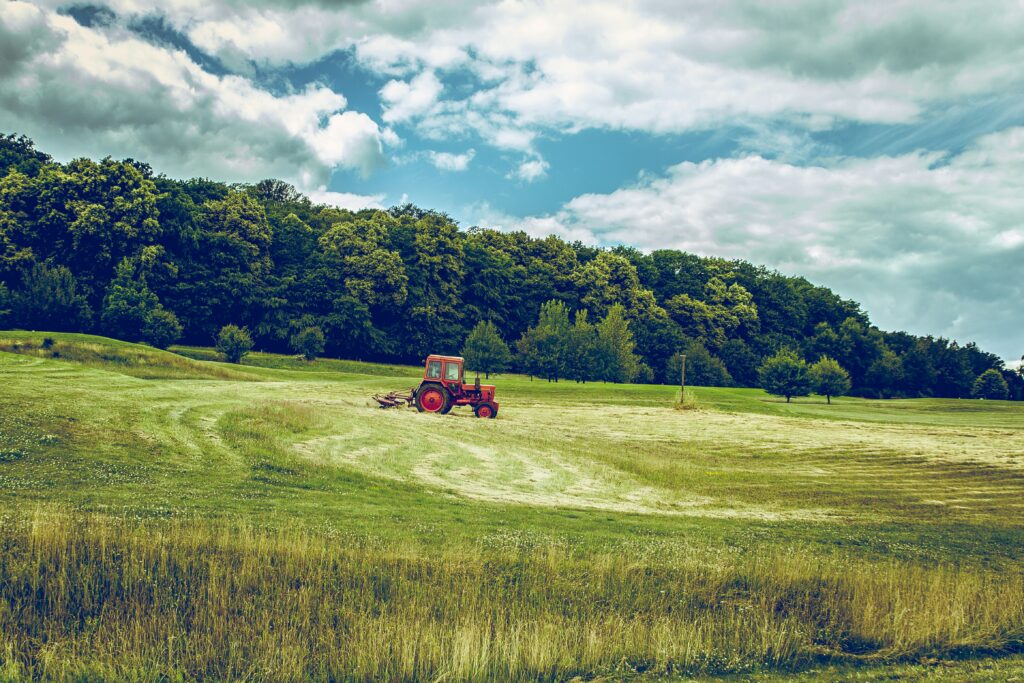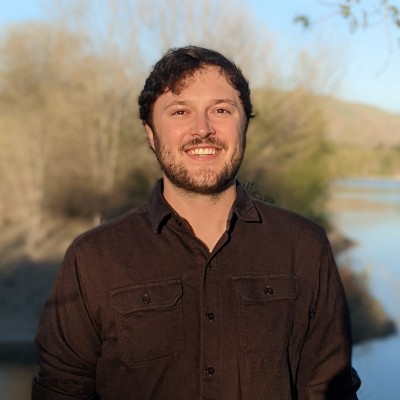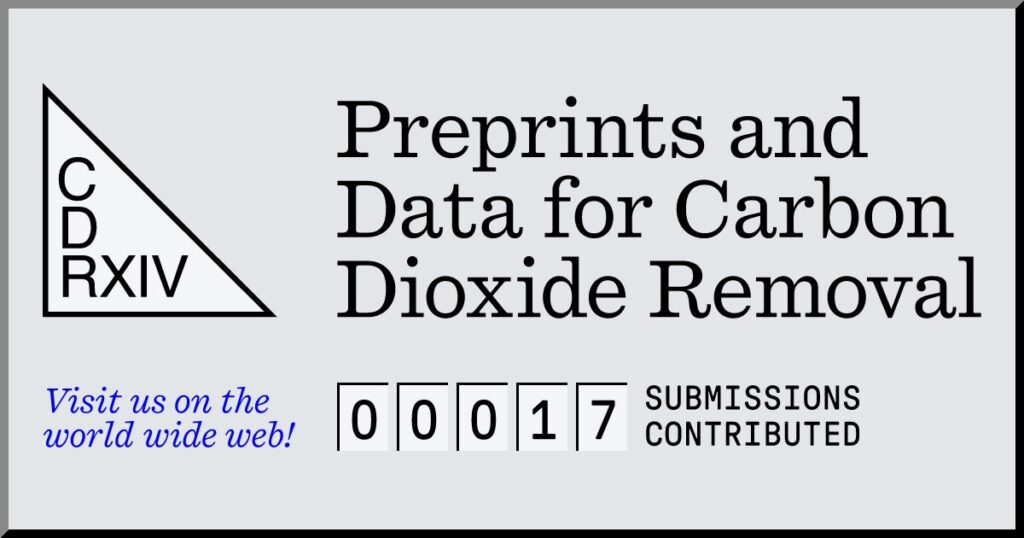New Archive CDRXIV Captures Preprints for CDR Advancement
Screenshot from the CDRVIX website, as of June 6
Recent estimates indicate that over 7 billion tonnes of carbon dioxide would need to be removed from the atmosphere by 2050 to meet climate goals, elevating the need for innovative carbon sequestration fixes. Within the past few decades, carbon dioxide removal (CDR) projects have emerged as a promising solution and potential investment opportunity. Despite this, knowledge gaps remain in the CDR field, including what solutions are most effective, how effective each solution is, and the full scope of ecological and socioeconomic ramifications they may present.

One barrier to resolving these gaps is the lack of centralization of CDR research. CDR is studied by researchers across several academic fields. Numerous stakeholders generate data, publish research, and implement solutions. In 2012, Remineralize the Earth launched a research database dedicated to soil remineralization and enhanced rock weathering (ERW) to attempt to centralize some of this information. At the time, it was the only existing research database dedicated to soil remineralization.
On May 14, 2025, the climate solutions non-profit CarbonPlan announced the development of a similar service: CDRXIV (pronounced: cee-dee-archive), a server housing preprints and datasets pertaining to CDR—including research on the effectiveness of various ERW projects. Similar to other scientific preprint servers like bioRxiv and arXiv, the platform only houses papers that have not yet undergone peer-review or been published elsewhere, accelerating the speed at which results can be shared.
Under this paradigm, ERW preprints and datasets can be consolidated under a single server, without the barrier of a paywall or the lack of coordination of the numerous scientific journals. It also provides the opportunity for academic ERW research to interact with data generated by corporations and nonprofits.
While peer-review is crucial for evaluating scientific rigor, preprint servers have emerged as a vital resource for expedited data sharing. In this way, they provide a forum for research to be discussed before it is evaluated as a potential journal article.
As the creators of the archive wrote in a launch announcement, “instead of taking months, or sometimes years, before new results are published, preprint servers post them in a matter of hours or days. The model helps new findings reach more researchers faster, accelerating scientific scrutiny and learning.”

CDRXIV’s screening process typically takes 1-4 business days, and once resources are listed on the server, they can be cited similarly to journal articles via digital object identifiers (DOIs) and can be updated post-peer review.
While speed is essential to elevating ERW technologies, several concerns also surround preprint servers. The CDRXIV website stresses that: “The screening step does not evaluate the scientific merit or conclusions of any submission,” and that submissions are only screened for essential criteria to prevent plagiarism, irrelevance, and harmful content. Currently, this screening process is conducted by a review team consisting of nine screeners affiliated with various institutions.
As submissions increase, maintaining the quality of submissions often becomes challenging, opening up the potential for the spread of misinformation. Detailed review happens after resources are published on a preprint server, where the responsibility of evaluating projects falls to the users of the archive. Because resources are open source, they can be viewed and used by any individual. The hope is that with increased use will come increased opportunities for experts to notice potential errors and weaknesses, preventing the spread of false or unverified claims.
At the same time, researchers are sometimes wary of the potential “scooping” of ideas before publication. However, many now embrace preprints as a way to gain early visibility of their research and therefore increase the chances of publication.
Unlike other preprint servers, CDRXIV also aims to house datasets generated by non-academic resources, including those with commercial interests. As more entities use the platform, additional concerns surrounding intellectual property, data privacy, or even legality may arise. As the platform is still new, it is yet to be seen if these barriers will significantly detract from CDRXIV’s mission.
In an interview with the Reversing Climate Change Podcast, Freya Chay, the Carbon Removal program lead at CarbonPlan and Advisory Board Member for CDRXIV, and Tyler Kukla, a research scientist at CarbonPlan and CDRXIV content manager, discussed the challenges further, emphasizing that open CDR science allows the possibility of more innovative solutions, opportunities for collaboration, and building off of existing datasets. Crucially, the interaction of these resources may assist in bridging the gap between concept and implementation.

One of the prizes of open science is that you start to get data syntheses. You can bring a bunch of different data sets together to paint this picture that nobody else can see from the specific experiments that they’re working on or that the point sources that they’re looking at. And this is where we often see across fields like big steps forward in scientific progress and understanding.
Tyler Kukla
As of June 22, the platform already hosts 20 submissions spanning multiple areas of carbon removal, with most focusing on geochemical CDR and the removal process itself. Resources currently include several ERW-focused preprints, including “A Direct-Measurement Framework for Enhanced Rock Weathering”, “Photosynthesis in Rivers as a Loss Pathway for ERW-Derived DIC and Alkalinity,” and “Mass-Balance MRV for Carbon Dioxide Removal by Enhanced Rock Weathering.” The database also contains three datasets from The Data Quarry, a service spearheaded by Cascade Climate that aims to consolidate data related to commercial ERW.
While CDRXIV’s reach extends beyond ERW, additional resources from other CDR efforts may present the opportunity for cross-collaboration.
As stated by the creators of the archive,
Different carbon removal approaches share many of the same problems, so advances in one area often matter for others. The lessons around comparing a CDR intervention to a baseline, for example, span policy and the physical sciences and apply to almost every CDR pathway. CDRXIV helps results like these reach researchers across disciplines faster.
As this is only the beginning for the platform, the CDRXIV team encourages researchers to submit preprints and datasets to help the repository evolve. As additional submissions are made, the preprints and data shared through CDRXIV will paint a broader, more integrated picture of the state of carbon removal technologies and implementations.
Bayleigh Murray is an environmental data analyst and science writer based in South Carolina, U.S.A. She has a research background in microbial ecology and a professional background in environmental assessments. She holds a B.S. in Molecular & Cellular Biology and Earth & Planetary Sciences from Johns Hopkins University and has written and edited popular science features for the Johns Hopkins News-Letter and the Triple Helix Science and Society Review. She is an avid blogger and is passionate about exploring the intersections of science and culture.
Support us on Patreon
Thank you for joining us today! Please become a member of RTE and support us on Patreon. Unlike many larger organizations, we work with a team of determined and passionate volunteers to get our message out. We aim to continue to increase the awareness of remineralization to initiate projects across the globe that remineralize soils, grow nutrient dense food, regenerate our forests’ and stabilize the climate – with your help! If you can, please support us on a monthly basis from just $2, rest assured that you are making a big impact every single month in support of our mission. Thank you!








Got something to say?